The wingman is no longer loyal, meet the newly named MQ28 Ghost bat Loyal Wingman given MQ-28A Ghost Bat designation | ADBR The Ghost bat ( Macroderma gigas) is our only carnivorous bat see Ghost Bat
Navigation
Install the app
How to install the app on iOS
Follow along with the video below to see how to install our site as a web app on your home screen.
Note: This feature may not be available in some browsers.
More options
-


LIVE: Richmond v Melbourne - 7:25PM Wed
Squiggle tips Demons at 77% chance -- What's your tip? -- Team line-ups »
You are using an out of date browser. It may not display this or other websites correctly.
You should upgrade or use an alternative browser.
You should upgrade or use an alternative browser.
Mod. Notice Technological advances in weaponry
- Thread starter Werewolf
- Start date
- Tagged users None
I agree it does, but Dr Google couldn't help. Quite a few other bat or ghost squadrons but no Ghost Bat squadron. Good name. Labelling is important.Was there ever a Ghost Bat F-14 squadron? The name does sound like it's been used before
These aren't technological advances, rather fails. Having spent a significant part of my life failing, I've developed an intellectual interest in failure. These British aircraft can all be considered failures in one way or another, some are technical, some it's just the wrong time. There are some really nice aircraft pics in the article and what could be cooler than seaplane fighters.
Flawed Concepts: a Litany of Failed British Aircraft
I don't know the Hushkit site bit it's got a lot of fun aviation articles and nice imagery.
From which came these nice aircraft images, Saab 37 Viggens, the older Saab 35 Draken and the Saab 39 Gripen

Image came from here Top 12 Swedish aircraft It has a net video of Viggens flying off roads etc. If the Viggens didn't scare the Russians, much of the sound track would.
Flawed Concepts: a Litany of Failed British Aircraft
I don't know the Hushkit site bit it's got a lot of fun aviation articles and nice imagery.
From which came these nice aircraft images, Saab 37 Viggens, the older Saab 35 Draken and the Saab 39 Gripen
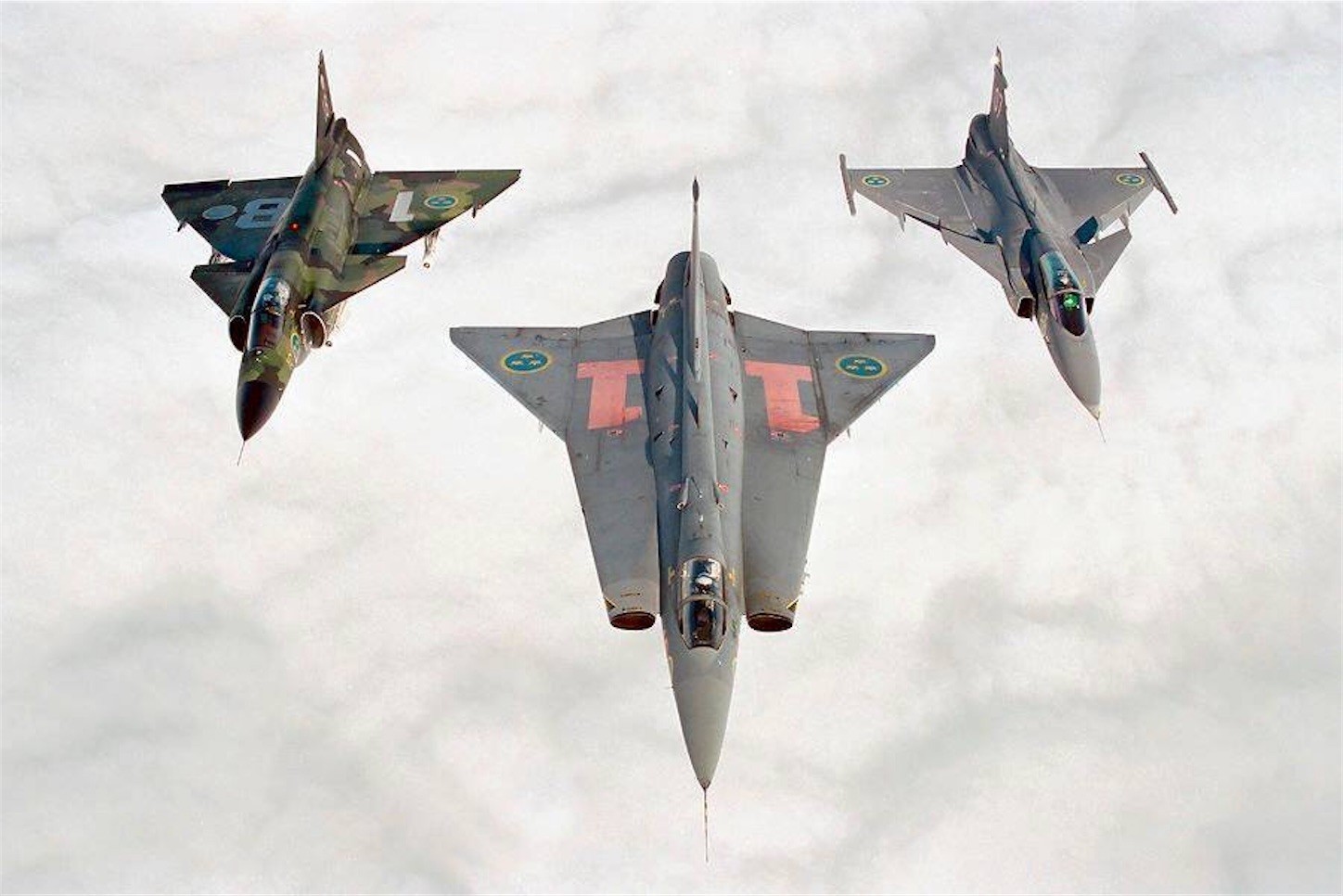
Image came from here Top 12 Swedish aircraft It has a net video of Viggens flying off roads etc. If the Viggens didn't scare the Russians, much of the sound track would.
Werewolf
Underminer
- Thread starter
- #55
Shifting to the ground war and not surprisingly tanks (MBTs and IFVs) are taking a beating from ATGMs in the Russia-Ukraine war.
The Russians anticipated this and improvised "dining tables" on top of their T-72/80/90 tanks (which were already coated with explosive reactive armour), but they appear to have suffered heavy losses nonetheless. The cost in both money and human lives is something they can ill afford.
They haven't deployed their brand new T-14s or T-15s yet (each equipped with their latest active protection system "Afganit"), but it seems they too would face the same problems from top-attack missiles such as the Javelin. At least these latest vehicles represent the benchmark in crew protection with the crew sitting low down in the hull and separated from the ammunition (!!), but Russia currently lacks the funds to mass produce them.
This problem hasn't been limited to Russian tanks either; Turkish Leopard 2A4s and Iraqi M1A1s have been blown up by ATGMs in recent years. At the same time, the addition of electro-optical jammers (see Sarab APS) greatly increased the survivability of Syrian T-72s.
So history repeats. Almost 50 years ago, simple wire-guided ATGMs threatened to drive the MBT to extinction. Rolled/cast steel gave way to composite armour and ERA plates, while active protection systems were developed to provide another layer of protection. At the same time, MCLOS and SACLOS missiles were supplanted by the likes of the Javelin, Spike and NLAW. Some of these warheads can penetrate over a metre of steel! Providing that level of protection is simply impossible for any vehicle under 60 tonnes, and otherwise only achievable on the frontal arc... of the turret... if you're lucky
Once again, the situation for tankers is dire. Paradoxically, their heavily armoured beast has become a death trap
Rough terrain means there will always be a place for tracked combat vehicles, but perhaps IFVs and SP artillery will become the dominant force - and the latter fight far away from the frontlines anyway. IMO the MBT will adapt to survive the modern battlefield, with at least one of these changes:
(A) Hard-kill APS will become an essential component of the modern MBT. The Trophy APS has made Israel's Merkava tanks practically invincible in the last decade. Of course a soft-kill jamming system can provide another layer of protection, but that's useless against unguided RPGs.
(B) Unmanned MBTs will be introduced. The age of robotics and AI has arrived and no doubt several countries will go down this path. Still expensive to lose, but no more need for crew protection. This isn't the best option since humans are required for field maintenance.
(C) Each MBT has an escort vehicle with radar to track all missile threats, an electro-optical jamming suite and a hard-kill APS (whether that's an autocannon firing proximity-fused HE shells or the usual grenade launcher) to destroy an incoming missile. An IFV might be adapted to fill this role.
The Russians anticipated this and improvised "dining tables" on top of their T-72/80/90 tanks (which were already coated with explosive reactive armour), but they appear to have suffered heavy losses nonetheless. The cost in both money and human lives is something they can ill afford.
They haven't deployed their brand new T-14s or T-15s yet (each equipped with their latest active protection system "Afganit"), but it seems they too would face the same problems from top-attack missiles such as the Javelin. At least these latest vehicles represent the benchmark in crew protection with the crew sitting low down in the hull and separated from the ammunition (!!), but Russia currently lacks the funds to mass produce them.
This problem hasn't been limited to Russian tanks either; Turkish Leopard 2A4s and Iraqi M1A1s have been blown up by ATGMs in recent years. At the same time, the addition of electro-optical jammers (see Sarab APS) greatly increased the survivability of Syrian T-72s.
So history repeats. Almost 50 years ago, simple wire-guided ATGMs threatened to drive the MBT to extinction. Rolled/cast steel gave way to composite armour and ERA plates, while active protection systems were developed to provide another layer of protection. At the same time, MCLOS and SACLOS missiles were supplanted by the likes of the Javelin, Spike and NLAW. Some of these warheads can penetrate over a metre of steel! Providing that level of protection is simply impossible for any vehicle under 60 tonnes, and otherwise only achievable on the frontal arc... of the turret... if you're lucky

Once again, the situation for tankers is dire. Paradoxically, their heavily armoured beast has become a death trap
Rough terrain means there will always be a place for tracked combat vehicles, but perhaps IFVs and SP artillery will become the dominant force - and the latter fight far away from the frontlines anyway. IMO the MBT will adapt to survive the modern battlefield, with at least one of these changes:
(A) Hard-kill APS will become an essential component of the modern MBT. The Trophy APS has made Israel's Merkava tanks practically invincible in the last decade. Of course a soft-kill jamming system can provide another layer of protection, but that's useless against unguided RPGs.
(B) Unmanned MBTs will be introduced. The age of robotics and AI has arrived and no doubt several countries will go down this path. Still expensive to lose, but no more need for crew protection. This isn't the best option since humans are required for field maintenance.
(C) Each MBT has an escort vehicle with radar to track all missile threats, an electro-optical jamming suite and a hard-kill APS (whether that's an autocannon firing proximity-fused HE shells or the usual grenade launcher) to destroy an incoming missile. An IFV might be adapted to fill this role.
Tanks are on a similar curve to warships, needing to become big, complex and expensive to survive. I don't know what 'design pattern' will emerge, but I suspect you are right about Unmanned MBT and they will be deployed as a fleet with other vehicles that offer supporting capabilities. Current combined arms is really an example of it, one which the Russians seem to have forgotten.Shifting to the ground war and not surprisingly tanks (MBTs and IFVs) are taking a beating from ATGMs in the Russia-Ukraine war.
The Russians anticipated this and improvised "dining tables" on top of their T-72/80/90 tanks (which were already coated with explosive reactive armour), but they appear to have suffered heavy losses nonetheless. The cost in both money and human lives is something they can ill afford.
They haven't deployed their brand new T-14s or T-15s yet (each equipped with their latest active protection system "Afganit"), but it seems they too would face the same problems from top-attack missiles such as the Javelin. At least these latest vehicles represent the benchmark in crew protection with the crew sitting low down in the hull and separated from the ammunition (!!), but Russia currently lacks the funds to mass produce them.
This problem hasn't been limited to Russian tanks either; Turkish Leopard 2A4s and Iraqi M1A1s have been blown up by ATGMs in recent years. At the same time, the addition of electro-optical jammers (see Sarab APS) greatly increased the survivability of Syrian T-72s.
So history repeats. Almost 50 years ago, simple wire-guided ATGMs threatened to drive the MBT to extinction. Rolled/cast steel gave way to composite armour and ERA plates, while active protection systems were developed to provide another layer of protection. At the same time, MCLOS and SACLOS missiles were supplanted by the likes of the Javelin, Spike and NLAW. Some of these warheads can penetrate over a metre of steel! Providing that level of protection is simply impossible for any vehicle under 60 tonnes, and otherwise only achievable on the frontal arc... of the turret... if you're lucky
Once again, the situation for tankers is dire. Paradoxically, their heavily armoured beast has become a death trap
Rough terrain means there will always be a place for tracked combat vehicles, but perhaps IFVs and SP artillery will become the dominant force - and the latter fight far away from the frontlines anyway. IMO the MBT will adapt to survive the modern battlefield, with at least one of these changes:
(A) Hard-kill APS will become an essential component of the modern MBT. The Trophy APS has made Israel's Merkava tanks practically invincible in the last decade. Of course a soft-kill jamming system can provide another layer of protection, but that's useless against unguided RPGs.
(B) Unmanned MBTs will be introduced. The age of robotics and AI has arrived and no doubt several countries will go down this path. Still expensive to lose, but no more need for crew protection. This isn't the best option since humans are required for field maintenance.
(C) Each MBT has an escort vehicle with radar to track all missile threats, an electro-optical jamming suite and a hard-kill APS (whether that's an autocannon firing proximity-fused HE shells or the usual grenade launcher) to destroy an incoming missile. An IFV might be adapted to fill this role.
I was following up earlier posts about aircraft costs, and found this about the sustainment cost of RAAFs combat jets.
'The actual sustainment budget for Super Hornet and Growler in RAAF service has been AUD$455m for 19-20 and in 20-21 was AUD$431m.
These costings are for a fleet of 35x heavy-weight twin engine fighters, inclusive of a very substantial spiral capability upgrade in lockstep with the USN. Inclusive of all costs you are looking at $61,571 per aircraft per hour (funded at a standard 200hrs per aircraft per year). However I wouldn’t take this figure as gospel due to the extensive upgrades they are going through, not least of which includes modern EW pods for Growler.
Our 40x strong force of JSF during 2020-2021 was funded at AUD$270m. (CPFH around AUD$33,750 at 40 aircraft per 200hrs for each airframe).'
Combat jets are an expensive business to own and sustain.
Mofra
Moderator
- Dec 6, 2005
- 67,092
- 198,370
- AFL Club
- Western Bulldogs
- Other Teams
- Footscray, Coney Island Warriors
- Moderator
- #57
These aren't technological advances, rather fails. Having spent a significant part of my life failing, I've developed an intellectual interest in failure. These British aircraft can all be considered failures in one way or another, some are technical, some it's just the wrong time. There are some really nice aircraft pics in the article and what could be cooler than seaplane fighters.
Flawed Concepts: a Litany of Failed British Aircraft
I don't know the Hushkit site bit it's got a lot of fun aviation articles and nice imagery.
From which came these nice aircraft images, Saab 37 Viggens, the older Saab 35 Draken and the Saab 39 Gripen

Image came from here Top 12 Swedish aircraft It has a net video of Viggens flying off roads etc. If the Viggens didn't scare the Russians, much of the sound track would.
Interesting that the Gripen is still in the hunt for a Canadian contract:
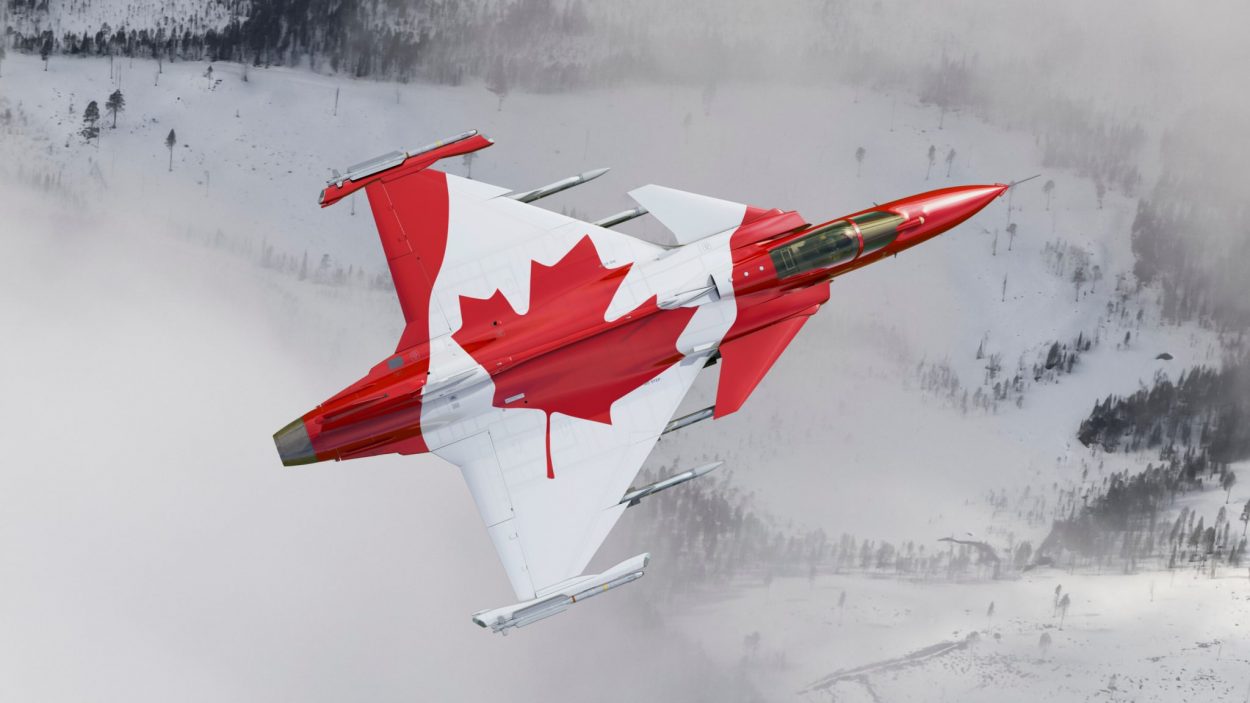
Upset By ‘Politically Influenced’ F-35 Deal, SAAB Pins Hopes On ‘Impartial’ Canada For Gripen Fighter Jet Contract
Finland’s decision to acquire the US-made F-35 stealth fighter seems to have upset Saab, the maker of the Gripen jet. However, its chief executive remains optimistic about its chances of winning a Canadian contract later this year. Pontoon Bridge Via ‘World’s Most Radioactive Contaminated Area’...
 eurasiantimes.com
eurasiantimes.com
Also notes the Gripen is in the frame for an Indian contract. The pressure to divest itself from a Russian-heavy military supply chain in the event of sanctions may work in Saab's favour here.
Mofra
Moderator
- Dec 6, 2005
- 67,092
- 198,370
- AFL Club
- Western Bulldogs
- Other Teams
- Footscray, Coney Island Warriors
- Moderator
- #58
As the crossbow defeated the battlefield supremacy of the knight. History repeats, and repeatsShifting to the ground war and not surprisingly tanks (MBTs and IFVs) are taking a beating from ATGMs in the Russia-Ukraine war.
The Russians anticipated this and improvised "dining tables" on top of their T-72/80/90 tanks (which were already coated with explosive reactive armour), but they appear to have suffered heavy losses nonetheless. The cost in both money and human lives is something they can ill afford.
They haven't deployed their brand new T-14s or T-15s yet (each equipped with their latest active protection system "Afganit"), but it seems they too would face the same problems from top-attack missiles such as the Javelin. At least these latest vehicles represent the benchmark in crew protection with the crew sitting low down in the hull and separated from the ammunition (!!), but Russia currently lacks the funds to mass produce them.
This problem hasn't been limited to Russian tanks either; Turkish Leopard 2A4s and Iraqi M1A1s have been blown up by ATGMs in recent years. At the same time, the addition of electro-optical jammers (see Sarab APS) greatly increased the survivability of Syrian T-72s.
So history repeats. Almost 50 years ago, simple wire-guided ATGMs threatened to drive the MBT to extinction. Rolled/cast steel gave way to composite armour and ERA plates, while active protection systems were developed to provide another layer of protection. At the same time, MCLOS and SACLOS missiles were supplanted by the likes of the Javelin, Spike and NLAW. Some of these warheads can penetrate over a metre of steel! Providing that level of protection is simply impossible for any vehicle under 60 tonnes, and otherwise only achievable on the frontal arc... of the turret... if you're lucky
Once again, the situation for tankers is dire. Paradoxically, their heavily armoured beast has become a death trap
Rough terrain means there will always be a place for tracked combat vehicles, but perhaps IFVs and SP artillery will become the dominant force - and the latter fight far away from the frontlines anyway. IMO the MBT will adapt to survive the modern battlefield, with at least one of these changes:
(A) Hard-kill APS will become an essential component of the modern MBT. The Trophy APS has made Israel's Merkava tanks practically invincible in the last decade. Of course a soft-kill jamming system can provide another layer of protection, but that's useless against unguided RPGs.
(B) Unmanned MBTs will be introduced. The age of robotics and AI has arrived and no doubt several countries will go down this path. Still expensive to lose, but no more need for crew protection. This isn't the best option since humans are required for field maintenance.
(C) Each MBT has an escort vehicle with radar to track all missile threats, an electro-optical jamming suite and a hard-kill APS (whether that's an autocannon firing proximity-fused HE shells or the usual grenade launcher) to destroy an incoming missile. An IFV might be adapted to fill this role.
Nuggs Bunny
Moderator
- Moderator
- #59
It's not surprising because this hasn't been a conventional war of great powers where two evenly equipped adversaries have deployed armoured troops against each other, rather the Ukrainians were quick to adopt a defence in depth and the Russian tanks that are being lost to ATGMs seem to be commonly happening where columns of tanks are being ambushed at close range and do not seem to be protected by supporting infantry. No matter what protection an armoured vehicle is fitted with, whether composite armour, NERA/ERA or APS, it is incredibly difficult to package protection against close range threats which has been why the west has adopted a strict doctrine of combined arms warfare to ensure that tanks always advance with infantry as protection. It cannot be understated how difficult it is to be a tanker fighting without infantry support, as the inherent design of a tank makes awareness of one's surroundings difficult and detection of threats nearly impossible from many angles.Shifting to the ground war and not surprisingly tanks (MBTs and IFVs) are taking a beating from ATGMs in the Russia-Ukraine war.
The Russians anticipated this and improvised "dining tables" on top of their T-72/80/90 tanks (which were already coated with explosive reactive armour), but they appear to have suffered heavy losses nonetheless. The cost in both money and human lives is something they can ill afford.
They haven't deployed their brand new T-14s or T-15s yet (each equipped with their latest active protection system "Afganit"), but it seems they too would face the same problems from top-attack missiles such as the Javelin. At least these latest vehicles represent the benchmark in crew protection with the crew sitting low down in the hull and separated from the ammunition (!!), but Russia currently lacks the funds to mass produce them.
This problem hasn't been limited to Russian tanks either; Turkish Leopard 2A4s and Iraqi M1A1s have been blown up by ATGMs in recent years. At the same time, the addition of electro-optical jammers (see Sarab APS) greatly increased the survivability of Syrian T-72s.
So history repeats. Almost 50 years ago, simple wire-guided ATGMs threatened to drive the MBT to extinction. Rolled/cast steel gave way to composite armour and ERA plates, while active protection systems were developed to provide another layer of protection. At the same time, MCLOS and SACLOS missiles were supplanted by the likes of the Javelin, Spike and NLAW. Some of these warheads can penetrate over a metre of steel! Providing that level of protection is simply impossible for any vehicle under 60 tonnes, and otherwise only achievable on the frontal arc... of the turret... if you're lucky
Once again, the situation for tankers is dire. Paradoxically, their heavily armoured beast has become a death trap
Rough terrain means there will always be a place for tracked combat vehicles, but perhaps IFVs and SP artillery will become the dominant force - and the latter fight far away from the frontlines anyway. IMO the MBT will adapt to survive the modern battlefield, with at least one of these changes:
(A) Hard-kill APS will become an essential component of the modern MBT. The Trophy APS has made Israel's Merkava tanks practically invincible in the last decade. Of course a soft-kill jamming system can provide another layer of protection, but that's useless against unguided RPGs.
(B) Unmanned MBTs will be introduced. The age of robotics and AI has arrived and no doubt several countries will go down this path. Still expensive to lose, but no more need for crew protection. This isn't the best option since humans are required for field maintenance.
(C) Each MBT has an escort vehicle with radar to track all missile threats, an electro-optical jamming suite and a hard-kill APS (whether that's an autocannon firing proximity-fused HE shells or the usual grenade launcher) to destroy an incoming missile. An IFV might be adapted to fill this role.
I won't dwell on why there has seemingly been such poor infantry support for armour in Ukraine as I'd only be speculating however the russian doctrine for armoured warfare has always more closely mirrored their experiences in world war 2 where it was more common for small units of 1-4 tanks to breakthrough enemy lines and attempt to flank around larger formations. This is part of the reason why Russia has also persisted with the development of GLATGMs and APS whereas the west has traditionally relied upon anti-tank missiles to be carried separately by infantry or other vehicles and relied on the protection against infantry-launched ATGMs to come from effective support from their own infantry to identify threats and neutralise them before they have the chance to engage. Russian strategy has always been more accepting of inevitable losses of armoured vehicles during any operation in contrast to the west which is evidenced right down to the basic design of each faction's MBT i.e Russian tanks are also smaller and lighter in contrast to the larger, heavier western tanks. Russian tanks are advantaged in their build cost, their supply chain impact and their tactical & strategic mobility yet in armoured vehicles, weight means protection and crew/mobility protection is one area where western tanks have maintained an advantage since the 1970s.
However, there will always be a role for armoured vehicles. Wars cannot be won without infantry - the current events in Ukraine are testament to this fact. Infantry will always need protection from other infantry, thus the need for armoured vehicles. And other armoured vehicles carrying large calibre guns capable of firing high velocity rounds will always be needed to attack these vehicles i.e. the MBT. The battle of 73 easting in 1991 proved convincingly that $ for $, the most effective way to defeat an armoured vehicle is a kinetic energy penetrator.
Mofra
Moderator
- Dec 6, 2005
- 67,092
- 198,370
- AFL Club
- Western Bulldogs
- Other Teams
- Footscray, Coney Island Warriors
- Moderator
- #60
Well this is interesting. Indonesia pivoting towards western supplies and enhanced technical capacity
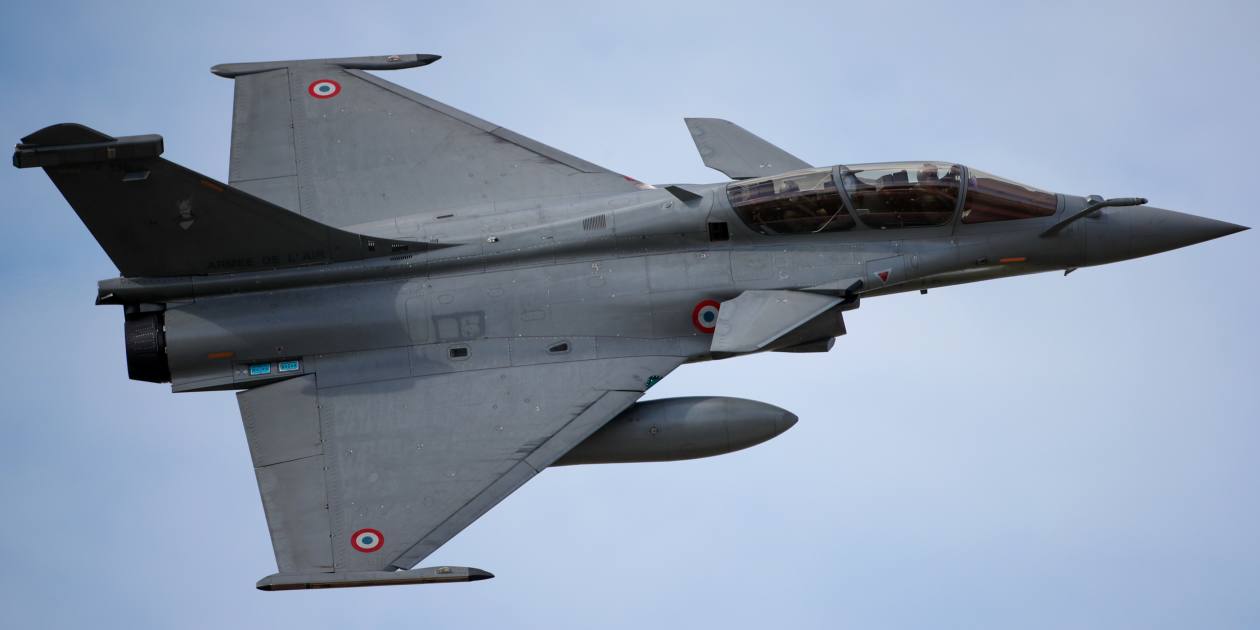
 asia.nikkei.com
asia.nikkei.com

Indonesia wins U.S. approval to buy F-15s after Rafale jet deal
French, Indonesian defense ministers also agree to cooperate on submarines
They have had trouble maintaining the Flankers and had low availability rates. Russian support has been poor, and they have been sourcing parts from other users. This turn towards western gear started well before Russia invasion of the Ukraine, but looks to be a good move for TNI-AU. I feel they should be consolidating their fleets, however they will be flying the following combat jets F15 (maybe), Su 27, Su 30, F16, Rafael, TA50 and Hawk 200, making a real mishmash of a fleet. None of them are in very large quantities and must be an absolute pig to maintain their fleets. I think there is also the fact Russian aircraft development hasn't really been moving forward very much, with the Flankers we may have seen the peak period of Russian aircraft design.Well this is interesting. Indonesia pivoting towards western supplies and enhanced technical capacity

Indonesia wins U.S. approval to buy F-15s after Rafale jet deal
French, Indonesian defense ministers also agree to cooperate on submarinesasia.nikkei.com
Mofra
Moderator
- Dec 6, 2005
- 67,092
- 198,370
- AFL Club
- Western Bulldogs
- Other Teams
- Footscray, Coney Island Warriors
- Moderator
- #62
Spot on - it's why air forces avoid multiple airframe types (although the Greeks notably used to mix their fleet as Turkey relied solely on F-16s so they took a mixture of F-16s and other airframes)They have had trouble maintaining the Flankers and had low availability rates. Russian support has been poor, and they have been sourcing parts from other users. This turn towards western gear started well before Russia invasion of the Ukraine, but looks to be a good move for TNI-AU. I feel they should be consolidating their fleets, however they will be flying the following combat jets F15 (maybe), Su 27, Su 30, F16, Rafael, TA50 and Hawk 200, making a real mishmash of a fleet. None of them are in very large quantities and must be an absolute pig to maintain their fleets. I think there is also the fact Russian aircraft development hasn't really been moving forward very much, with the Flankers we may have seen the peak period of Russian aircraft design.
The Flankers are very cheap for their supposed capability. Makes no difference if they can't get into the air.
The Yanks have been working very hard of reducing maintenance requirements of their airframes (which drives up the cost substantially). IIRC The F-14 Tomcats had a 20 hour maintenance cycle per 1 hour of flying time. Their replacement (the E/F model Super Hornets) reduced that down to 4 Hours.
NK launches an ICBM and produces a hilarious propaganda video.
The launch is at 4 minutes and includes some neat drone footage. I wonder how many times the poor NK citizens will have to watch this?
There is an unfortunate fact that is omitted from the video. This is not the Hwasong-17 rocket NK claims it is. The Hwasong-17 launch failed a few weeks ago and this believed to be the older Hwasong 15 masquerading as the new rocket Seoul Says North Korea Didn’t Test Hwasong-17 ICBM After All
If you can't trust NK to tell the truth, who can you trust to tell the truth?
The launch is at 4 minutes and includes some neat drone footage. I wonder how many times the poor NK citizens will have to watch this?
There is an unfortunate fact that is omitted from the video. This is not the Hwasong-17 rocket NK claims it is. The Hwasong-17 launch failed a few weeks ago and this believed to be the older Hwasong 15 masquerading as the new rocket Seoul Says North Korea Didn’t Test Hwasong-17 ICBM After All
If you can't trust NK to tell the truth, who can you trust to tell the truth?
The RAAF were going to be advancing the state of our weaponry with 12 MQ9B (Sky Guardian) drones however this is supposed to be cancelled AIR 7003 armed UCAV project cancelled - APDR A difficult to understand decision given recent performances of drones during conflicts. Perhaps they have a 'loyal wingman' derived strike drone planned, if not it's a very short sighted decision. The pollies stuff up defence spending constantly, look at the $3,000,000,000 AUD spent on the French subs all for nought, well not quite nought, we did trash Australian-French relations and piss the French off. Some might think that's worth 3 Billion dollars!
The last 3 PM' have all picked a different sub. We have a mighty ship building plan, but it guarantees we don't get a major combatant for at least a decade, while at the same time the Hobarts and the Anzac are going through major refurbishment and will be less available. What a mess! We are going to look foolish if the party starts in around 5 years as some predict. We will have less combatants to meet thechallenge than we do now.
The last 3 PM' have all picked a different sub. We have a mighty ship building plan, but it guarantees we don't get a major combatant for at least a decade, while at the same time the Hobarts and the Anzac are going through major refurbishment and will be less available. What a mess! We are going to look foolish if the party starts in around 5 years as some predict. We will have less combatants to meet thechallenge than we do now.
The other two factors that are killing them is due to their conscripts. 1. They barely are out of basic training and certainly not ready for war. 2. That and Russian's having conscripts means their NCO's are not experienced soldiers either. Western militaries with professional armies generally everyone knows the plan (to various details), so if the next guy / girl up is killed / wounded / out of communication, they can carry on. Russians are rigidly top-down control. Anything out of the ordinary they stop and wait for orders. Also part of why so many generals have been killed, they've had to go near / to front lines to direct stuff.It's not surprising because this hasn't been a conventional war of great powers where two evenly equipped adversaries have deployed armoured troops against each other, rather the Ukrainians were quick to adopt a defence in depth and the Russian tanks that are being lost to ATGMs seem to be commonly happening where columns of tanks are being ambushed at close range and do not seem to be protected by supporting infantry. No matter what protection an armoured vehicle is fitted with, whether composite armour, NERA/ERA or APS, it is incredibly difficult to package protection against close range threats which has been why the west has adopted a strict doctrine of combined arms warfare to ensure that tanks always advance with infantry as protection. It cannot be understated how difficult it is to be a tanker fighting without infantry support, as the inherent design of a tank makes awareness of one's surroundings difficult and detection of threats nearly impossible from many angles.
I won't dwell on why there has seemingly been such poor infantry support for armour in Ukraine as I'd only be speculating however the russian doctrine for armoured warfare has always more closely mirrored their experiences in world war 2 where it was more common for small units of 1-4 tanks to breakthrough enemy lines and attempt to flank around larger formations. This is part of the reason why Russia has also persisted with the development of GLATGMs and APS whereas the west has traditionally relied upon anti-tank missiles to be carried separately by infantry or other vehicles and relied on the protection against infantry-launched ATGMs to come from effective support from their own infantry to identify threats and neutralise them before they have the chance to engage. Russian strategy has always been more accepting of inevitable losses of armoured vehicles during any operation in contrast to the west which is evidenced right down to the basic design of each faction's MBT i.e Russian tanks are also smaller and lighter in contrast to the larger, heavier western tanks. Russian tanks are advantaged in their build cost, their supply chain impact and their tactical & strategic mobility yet in armoured vehicles, weight means protection and crew/mobility protection is one area where western tanks have maintained an advantage since the 1970s.
However, there will always be a role for armoured vehicles. Wars cannot be won without infantry - the current events in Ukraine are testament to this fact. Infantry will always need protection from other infantry, thus the need for armoured vehicles. And other armoured vehicles carrying large calibre guns capable of firing high velocity rounds will always be needed to attack these vehicles i.e. the MBT. The battle of 73 easting in 1991 proved convincingly that $ for $, the most effective way to defeat an armoured vehicle is a kinetic energy penetrator.
Add in the lack of coordination between services and it's obvious in retrospect the Russian military is a paper tiger compared to what they said they were (and we thought).
IMO it's why the West shouldn't be afraid to say to Russia 'We will never cross your border, either by land or air, but you've got a week to get out of Ukraine or anything on the ground or air there is toast'. The Russian airforce would be decimated by F-35's and F-22's. If they tried to go into Poland or the Baltics, A-10's and Apache's would show them what the Ukrainians did to their columns was only an entrée. This is the chance for the West to not only save millions suffering, but by putting Russia in it's box also ensure Taiwan isn't at risk of the same fate in the next decade (as the US / Europe would be free to concentrate on containing China).
Last edited:
More articles about a Hypersonix projects. Their original plan was a scramjet powered launch vehicle called the Dart. It would use a rocket booster to get to Mach 5, then use the scramjet vehicle to get up to Mach 20 before releasing the 3rd stage rocket to reach orbital velocity. The Spartan scramjet engine has already been 3D printed in Inconel
Australia's hypersonic UAV project to boost advanced materials (janes.com) The article describes the Dart CMP. A demonstrator/experiential platform to look mainly at material issues - Notice it's no longer framed as a launch vehicle for satellites, rather now as a 'hypersonic UAV' with a maximum speed of Mach 12. A small version of the proposed launch vehicle would make a powerful hypersonic missile itself, the larger launch vehicle could be a hypersonic 'bomber'. Given the interest of 'everyone' in Hypersonics, I suspect the technology will get more funding from the military as a weapon than as a space launch system.
This is a separate project to the ADFs hypersonic missile project though it involves some of the same folks from UQ.
Australia's hypersonic UAV project to boost advanced materials (janes.com) The article describes the Dart CMP. A demonstrator/experiential platform to look mainly at material issues - Notice it's no longer framed as a launch vehicle for satellites, rather now as a 'hypersonic UAV' with a maximum speed of Mach 12. A small version of the proposed launch vehicle would make a powerful hypersonic missile itself, the larger launch vehicle could be a hypersonic 'bomber'. Given the interest of 'everyone' in Hypersonics, I suspect the technology will get more funding from the military as a weapon than as a space launch system.
This is a separate project to the ADFs hypersonic missile project though it involves some of the same folks from UQ.
Werewolf
Underminer
- Thread starter
- #67
Russian tank losses; as other posters have already pointed out, more of an indictment on Russian training, morale and tactics rather than equipment deficiencies (although they could certainly do with hard-kill active protection on top of ERA and/or electro-optical jammers):
Mofra
Moderator
- Dec 6, 2005
- 67,092
- 198,370
- AFL Club
- Western Bulldogs
- Other Teams
- Footscray, Coney Island Warriors
Werewolf
Underminer
- Thread starter
- #69
Israel's Iron Beam directed energy defence system will be operational in the near future, having been successfully tested recently:
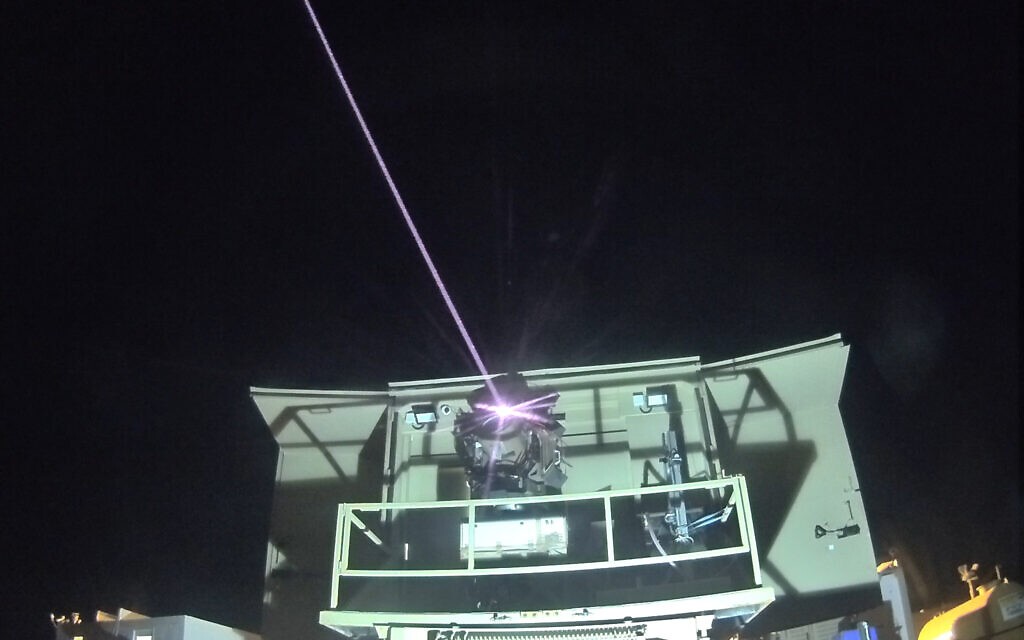
 www.timesofisrael.com
www.timesofisrael.com
It will add another (inner) layer of protection behind the much longer ranged Iron Dome, but it appears there will be a ~98% cost saving because shooting lasers is cheaper than shooting missiles! That said, it won't work as effectively under adverse atmospheric conditions.

In ‘game changer,’ Israeli laser-based air defense shoots down drones
Officials hail Iron Beam system after successful interceptions of guided and unguided projectiles; Gantz says all efforts being made for early deployment
It will add another (inner) layer of protection behind the much longer ranged Iron Dome, but it appears there will be a ~98% cost saving because shooting lasers is cheaper than shooting missiles! That said, it won't work as effectively under adverse atmospheric conditions.
Mofra
Moderator
- Dec 6, 2005
- 67,092
- 198,370
- AFL Club
- Western Bulldogs
- Other Teams
- Footscray, Coney Island Warriors
- Moderator
- #70
Airline pilots on a clear day may be nervous.Israel's Iron Beam directed energy defence system will be operational in the near future, having been successfully tested recently:

In ‘game changer,’ Israeli laser-based air defense shoots down drones
Officials hail Iron Beam system after successful interceptions of guided and unguided projectiles; Gantz says all efforts being made for early deploymentwww.timesofisrael.com
It will add another (inner) layer of protection behind the much longer ranged Iron Dome, but it appears there will be a ~98% cost saving because shooting lasers is cheaper than shooting missiles! That said, it won't work as effectively under adverse atmospheric conditions.
No doubt there is some energy dissipation over distance but it would be interesting to know what that is. Especially if they plan to mount the system to aircraft in the future.
War on the Rocks has a good article about loitering munitions Loitering Munitions in Ukraine and Beyond - War on the Rocks and this one from the Drive Army To Test Its Biggest Interactive Drone Swarm Ever Over Utah talks about exercise Edge 22 which will test swarms of drones used in conjunction with other assets.
The future is now. Skynet, argh.............
The future is now. Skynet, argh.............
The troubled Tiger attack helicopters the ADF are ridding themselves of are being upgraded in Europe. France, Spain ink deals to upgrade Tiger attack helicopters - Breaking Defense Yes, that is 65 million euros each, = $96 million AUD per craft!!! Ouch. You can buy an F35 and a spare engine for that.
Finally we are getting some big robot subs. Defence partners with Anduril on large Australian AUVs - Australian Defence Magazine

Great news. The founder of the company is Palmer Luckey, who was the primary developer of Oculus Rift, one of the first VR sets. This decision by the ADF really mirrors the Loyal Wingman program. Smaller agile groups dong advanced developments rapidly. Anduril are also responsible for the USAF Advanced Battle Management Systems.
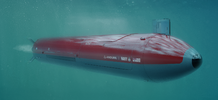
Great news. The founder of the company is Palmer Luckey, who was the primary developer of Oculus Rift, one of the first VR sets. This decision by the ADF really mirrors the Loyal Wingman program. Smaller agile groups dong advanced developments rapidly. Anduril are also responsible for the USAF Advanced Battle Management Systems.
Mesc
Ayahuascero
- Mar 30, 2008
- 8,331
- 7,462
- AFL Club
- Fremantle
- Other Teams
- South Freo , Coney Island Warriors.
Will there ever be anything more powerful than Nuclear weapons?
Not only robot subs for the RAN, but now a robot patrol boat, the recently retired HMAS Maitland, is being turned in to a unmanned platform. About time. Austal to Convert Decommissioned RAN Patrol Boat into USV - Naval News



